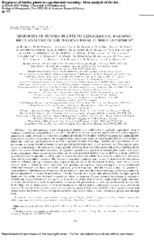Responses of tundra plants to experimental warming : meta-analysis of the international tundra experiment
| dc.contributor.author | Arft, A. M. | eng |
| dc.contributor.author | Walker, M. D. | eng |
| dc.contributor.author | Gurevitch, J. | eng |
| dc.contributor.author | Alatalo, J. M. | eng |
| dc.contributor.author | Bret-Harte, M. S. | eng |
| dc.contributor.author | Dale, M. | eng |
| dc.contributor.author | Diemer, M. | eng |
| dc.contributor.author | Gugerli, F. | eng |
| dc.contributor.author | Henry, G. H. R. | eng |
| dc.contributor.author | Jones, M. H. | eng |
| dc.contributor.author | Hollister, R. D. | eng |
| dc.contributor.author | Jónsdóttir, I. S. | eng |
| dc.contributor.author | Laine, K. | eng |
| dc.contributor.author | Lévesque, E. | eng |
| dc.contributor.author | Marion, G. M. | eng |
| dc.contributor.author | Molau, U. | eng |
| dc.contributor.author | Mølgaard, P. | eng |
| dc.contributor.author | Nordenhäll, U. | eng |
| dc.contributor.author | Raszhivin, V. | eng |
| dc.contributor.author | Robinson, C. H. | eng |
| dc.contributor.author | Starr, G. | eng |
| dc.contributor.author | Stenström, A. | eng |
| dc.contributor.author | Stenström, M. | eng |
| dc.contributor.author | Totland, Ørjan | eng |
| dc.contributor.author | Turner, P. L. | eng |
| dc.contributor.author | Walker, L. J. | eng |
| dc.contributor.author | Webber, P. J. | eng |
| dc.contributor.author | Welker, J. M. | eng |
| dc.contributor.author | Wookey, P. A. | eng |
| dc.date.accessioned | 2008-02-13T10:20:18Z | |
| dc.date.available | 2008-02-13T10:20:18Z | |
| dc.date.issued | 1999 | eng |
| dc.Published | Ecological Monographs 1999 69 (4): 491-511 | en |
| dc.identifier.issn | 0012-9615 | en_US |
| dc.identifier.uri | http://hdl.handle.net/1956/2583 | |
| dc.description.abstract | The International Tundra Experiment (ITEX) is a collaborative, multisite experiment using a common temperature manipulation to examine variability in species response across climatic and geographic gradients of tundra ecosystems. ITEX was designed specifically to examine variability in arctic and alpine species response to increased temperature. We compiled from one to four years of experimental data from 13 different ITEX sites and used meta-analysis to analyze responses of plant phenology, growth, and reproduction to experimental warming. Results indicate that key phenological events such as leaf bud burst and flowering occurred earlier in warmed plots throughout the study period; however, there was little impact on growth cessation at the end of the season. Quantitative measures of vegetative growth were greatest in warmed plots in the early years of the experiment, whereas reproductive effort and success increased in later years. A shift away from vegetative growth and toward reproductive effort and success in the fourth treatment year suggests a shift from the initial response to a secondary response. The change in vegetative response may be due to depletion of stored plant reserves, whereas the lag in reproductive response may be due to the formation of flower buds one to several seasons prior to flowering. Both vegetative and reproductive responses varied among life-forms; herbaceous forms had stronger and more consistent vegetative growth responses than did woody forms. The greater responsiveness of the herbaceous forms may be attributed to their more flexible morphology and to their relatively greater proportion of stored plant reserves. Finally, warmer, low arctic sites produced the strongest growth responses, but colder sites produced a greater reproductive response. Greater resource investment in vegetative growth may be a conservative strategy in the Low Arctic, where there is more competition for light, nutrients, or water, and there may be little opportunity for successful germination or seedling development. In contrast, in the High Arctic, heavy investment in producing seed under a higher temperature scenario may provide an opportunity for species to colonize patches of unvegetated ground. The observed differential response to warming suggests that the primary forces driving the response vary across climatic zones, functional groups, and through time. | en_US |
| dc.language.iso | eng | eng |
| dc.publisher | Ecological Society of America | en_US |
| dc.subject | Arctic tundra | eng |
| dc.subject | Experimental warming | eng |
| dc.subject | Global change | eng |
| dc.subject | Global warming | eng |
| dc.subject | International Tundra Experiment | eng |
| dc.subject | ITEX | eng |
| dc.subject | Meta-analysis | eng |
| dc.subject | Plant response patterns | eng |
| dc.subject | Spatiotemporal gradients | eng |
| dc.subject | Tundra plants | eng |
| dc.title | Responses of tundra plants to experimental warming : meta-analysis of the international tundra experiment | en_US |
| dc.type | Peer reviewed | |
| dc.type | Journal article | |
| dc.identifier.doi | https://doi.org/10.1890/0012-9615%281999%29069%5b0491%3arotpte%5d2.0.co%3b2 | |
| dc.subject.nsi | VDP::Matematikk og Naturvitenskap: 400::Zoologiske og botaniske fag: 480 | nob |
